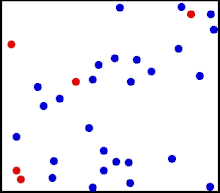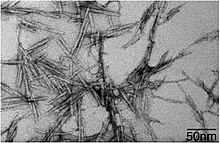183:, which when treated with CdS nanoparticles, see improved performance in their semiconductor materials through a reduction of the band gap energy. The usage of chemical deposition in particular allows for the crystallite orientation of CdS to be more favourable, though the process is quite time consuming. Research by S.A. Vanalakar in 2010 resulted in the successful production of cadmium sulfide nanoparticle film with a thickness of 139 nm, though this was only after the applied films were allowed to undergo deposition for 300 minutes. As the deposition time was increased for the film, not only was the film thickness found to increase, but the band gap of the resultant film decreased.
148:
528:
552:
540:
20:
58:
Chemosynthesis can be applied in many different areas of research, including in positional assembly of molecules. This is where molecules are assembled in certain positions in order to perform specific types of chemosynthesis using molecular building blocks. In this case synthesis is most efficiently
67:
molecules are also preferred, which is when molecules undergo minimal external stress, which leads to the molecule having a low internal energy. There are two main types of synthesis: additive and subtractive. In additive synthesis the structure starts with nothing, and then gradually molecular
171:
dictated by the properties of the surrounding bath. As such, this method of nanoscale chemosynthesis is often implemented when these properties are desired, and can be used for a wide range of nanomaterials, not just lead sulfide, due to the adjustable properties.
122:
reinforces the view that this is feasible by pointing out that several alternate means of creating complex proteins, mineral shells of mollusks and crustaceans, etc., evolved naturally, not all of them dependent on photosynthesis and a
68:
building blocks are added until the structure that is needed is created. In subtractive synthesis they start with a large molecule and remove building blocks one by one until the structure is achieved.
297:
Pawar, S.B.; Shaikh, J.S.; Devan, R.S.; Ma, Y.R.; Haranath, D.; Bhosale, P.N.; Patil, P.S. (2011). "Facile and low cost chemosynthesis of nanostructured PBS with tunable optical properties".
175:
As explained previously, the usage of chemical bath deposition allows for the synthesis of large deposits of nanofilm layers at a low cost, which is important in the mass production of
139:, the likelihood of humans being able to design an entirely new one is considered (by these advocates) to be near certainty in the long run, and possible within a generation.
167:(PbS) films. CBD synthesis of these films allows for both cost-effective and accurate assemblies, with grain type and size as well as optical properties of the
159:(CBD). This process enables large-scale synthesis of thin film layers of a variety of materials, and has been especially useful in providing such films for
108:
51:
of the natural phenomena above, and the entire class of non-photosynthetic chains by which complex molecules are constructed is described as
370:
43:
occur due to random thermal motion, a class which encompasses almost all of modern synthetic chemistry. The human-authored processes of
179:. The low cost associated with the synthesis of CdS through means of chemical deposition has seen CdS nanoparticles being applied to
458:
544:
363:
115:
could be produced by a chain of non-biological reactions that have been designed using the basic model of biology.
131:. Since more than one such pathway exists to creating complex molecules, even extremely specific ones such as
200:
Merkle, Ralph (2000). "Molecular building blocks and development strategies for molecular nanotechnology".
583:
532:
513:
356:
95:
claim that an artificial process can likewise exploit a chain of long-term storage, short-term storage,
443:
448:
393:
60:
423:
156:
28:
83:
and other natural processes create extremely complex molecules to the specifications contained in
578:
488:
503:
453:
23:
Random thermal (translational) motion of particles, with collisions acting as reaction "points"
238:
Jannasch, H. W.; Mottl, M. J. (1985-08-23). "Geomicrobiology of Deep-Sea
Hydrothermal Vents".
155:
Several methods of nanoscale chemosynthesis have been developed, a common variant of which is
498:
92:
418:
398:
306:
247:
44:
8:
433:
147:
310:
251:
379:
279:
217:
64:
36:
551:
478:
473:
468:
403:
271:
263:
221:
213:
40:
283:
556:
463:
438:
314:
255:
209:
164:
72:
508:
318:
259:
176:
160:
112:
79:
are mechanically manipulated to control reactions to human specification. Since
483:
428:
151:
Cellulose
Nanoparticles that can be synthesized through Chemosynthetic methods.
100:
80:
572:
493:
267:
168:
408:
275:
338:"Quantum Size Effects in Chemosynthesized Nanostructured CdS Thin Films."
128:
337:
180:
124:
48:
19:
348:
76:
132:
104:
96:
103:, and ultimately produce complex molecules which need not be
136:
88:
84:
341:Digest Journal of Nanomaterials and Biostructures.
296:
99:-like copying mechanisms similar to those in the
71:This form of engineering is then contrasted with
570:
364:
237:
371:
357:
75:, a hypothetical process where individual
146:
18:
571:
378:
199:
142:
352:
539:
332:
330:
328:
233:
231:
181:semiconductor sensitized solar cells
16:Process in molecular nanotechnology
13:
163:through the efficient creation of
14:
595:
325:
228:
63:with a small amount of linkages.
550:
538:
527:
526:
47:are accordingly represented as
290:
193:
1:
186:
59:performed through the use of
319:10.1016/j.apsusc.2011.10.069
260:10.1126/science.229.4715.717
7:
514:Volume combustion synthesis
10:
600:
444:Enantioselective synthesis
214:10.1088/0957-4484/11/2/309
522:
449:Fully automated synthesis
394:Artificial gene synthesis
386:
61:molecular building blocks
424:Custom peptide synthesis
157:chemical bath deposition
87:and stored long-term in
29:molecular nanotechnology
299:Applied Surface Science
504:Solvothermal synthesis
454:Hydrothermal synthesis
152:
24:
499:Solid-phase synthesis
150:
93:molecular engineering
22:
419:Convergent synthesis
399:Biomimetic synthesis
45:chemical engineering
434:Divergent synthesis
311:2011ApSS..258.1869P
252:1985Sci...229..717J
143:Modern applications
91:form, advocates of
584:Chemical synthesis
380:Chemical synthesis
153:
37:chemical synthesis
25:
566:
565:
479:Peptide synthesis
474:Organic synthesis
469:One-pot synthesis
404:Bioretrosynthesis
246:(4715): 717–725.
127:from the sun via
107:. For instance,
591:
554:
542:
541:
530:
529:
464:Mechanosynthesis
439:Electrosynthesis
373:
366:
359:
350:
349:
343:
336:Vanalakar, S.A.
334:
323:
322:
305:(5): 1869–1875.
294:
288:
287:
235:
226:
225:
197:
161:opto-electronics
118:Use of the term
113:carbon nanotubes
73:mechanosynthesis
599:
598:
594:
593:
592:
590:
589:
588:
569:
568:
567:
562:
518:
509:Total synthesis
382:
377:
347:
346:
335:
326:
295:
291:
236:
229:
198:
194:
189:
177:cadmium sulfide
145:
17:
12:
11:
5:
597:
587:
586:
581:
579:Nanotechnology
564:
563:
561:
560:
548:
536:
523:
520:
519:
517:
516:
511:
506:
501:
496:
491:
489:Retrosynthesis
486:
484:Radiosynthesis
481:
476:
471:
466:
461:
456:
451:
446:
441:
436:
431:
429:Direct process
426:
421:
416:
414:Chemosynthesis
411:
406:
401:
396:
390:
388:
384:
383:
376:
375:
368:
361:
353:
345:
344:
324:
289:
227:
202:Nanotechnology
191:
190:
188:
185:
144:
141:
120:chemosynthesis
81:photosynthesis
33:chemosynthesis
15:
9:
6:
4:
3:
2:
596:
585:
582:
580:
577:
576:
574:
559:
558:
553:
549:
547:
546:
537:
535:
534:
525:
524:
521:
515:
512:
510:
507:
505:
502:
500:
497:
495:
494:Semisynthesis
492:
490:
487:
485:
482:
480:
477:
475:
472:
470:
467:
465:
462:
460:
457:
455:
452:
450:
447:
445:
442:
440:
437:
435:
432:
430:
427:
425:
422:
420:
417:
415:
412:
410:
407:
405:
402:
400:
397:
395:
392:
391:
389:
385:
381:
374:
369:
367:
362:
360:
355:
354:
351:
342:
339:
333:
331:
329:
320:
316:
312:
308:
304:
300:
293:
285:
281:
277:
273:
269:
265:
261:
257:
253:
249:
245:
241:
234:
232:
223:
219:
215:
211:
207:
203:
196:
192:
184:
182:
178:
173:
170:
166:
162:
158:
149:
140:
138:
134:
130:
126:
121:
116:
114:
110:
109:sheet diamond
106:
102:
98:
94:
90:
86:
82:
78:
74:
69:
66:
62:
56:
54:
50:
46:
42:
38:
34:
30:
21:
555:
543:
531:
413:
409:Biosynthesis
340:
302:
298:
292:
243:
239:
208:(2): 89–99.
205:
201:
195:
174:
169:nanomaterial
165:lead sulfide
154:
119:
117:
70:
57:
52:
32:
26:
129:chlorophyll
573:Categories
187:References
135:edible to
125:food chain
65:Unstrained
49:biomimicry
268:0036-8075
222:250914545
77:molecules
41:reactions
533:Category
284:24859537
276:17841485
133:proteins
105:proteins
545:Commons
307:Bibcode
248:Bibcode
240:Science
35:is any
557:Portal
282:
274:
266:
220:
97:enzyme
53:chemo-
39:where
459:LASiS
387:Types
280:S2CID
218:S2CID
272:PMID
264:ISSN
137:fish
101:cell
315:doi
303:258
256:doi
244:229
210:doi
111:or
89:DNA
85:RNA
27:In
575::
327:^
313:.
301:.
278:.
270:.
262:.
254:.
242:.
230:^
216:.
206:11
204:.
55:.
31:,
372:e
365:t
358:v
321:.
317::
309::
286:.
258::
250::
224:.
212::
Text is available under the Creative Commons Attribution-ShareAlike License. Additional terms may apply.

